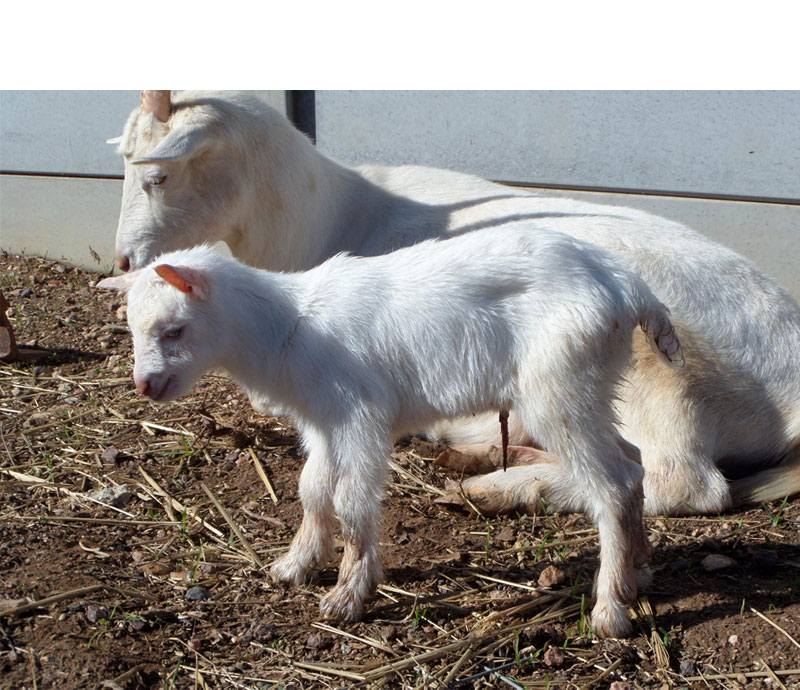
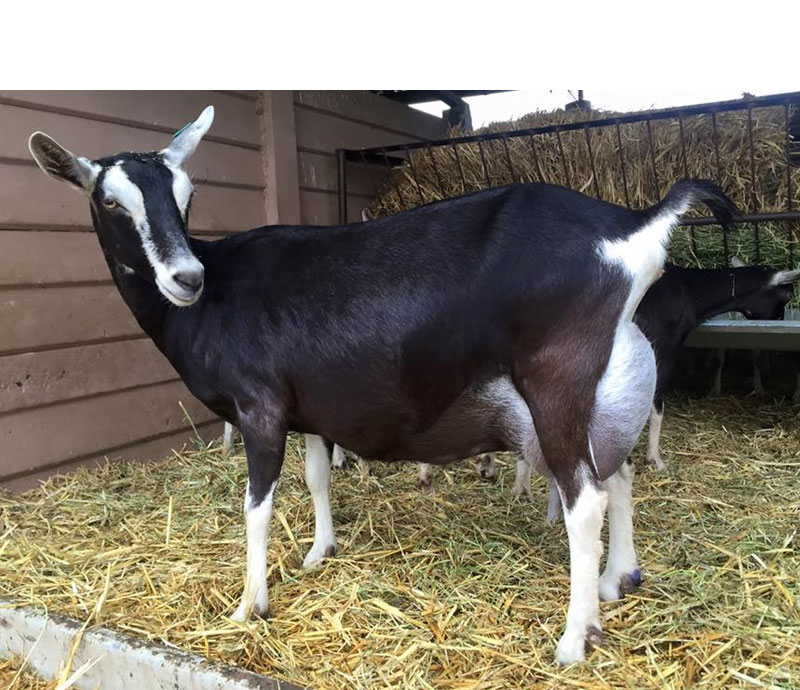

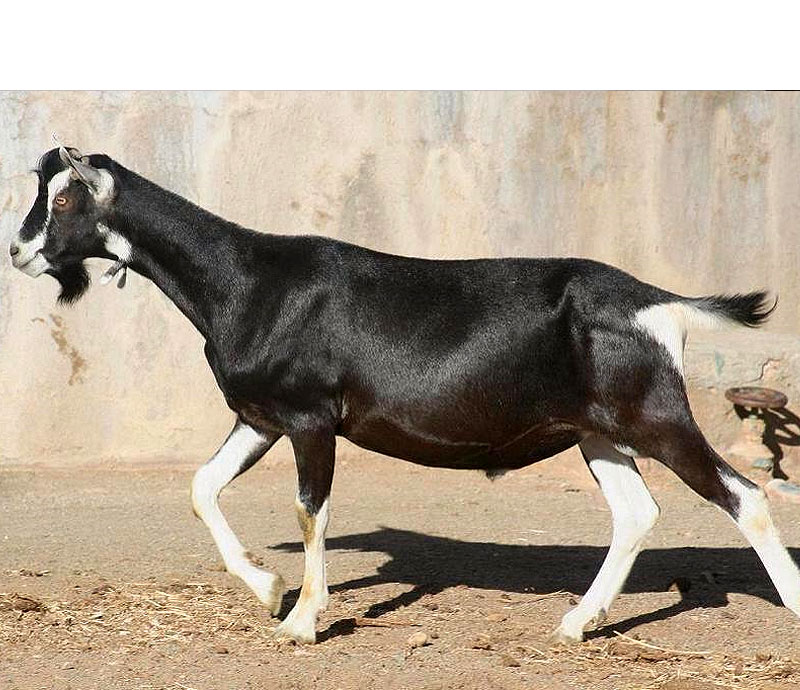
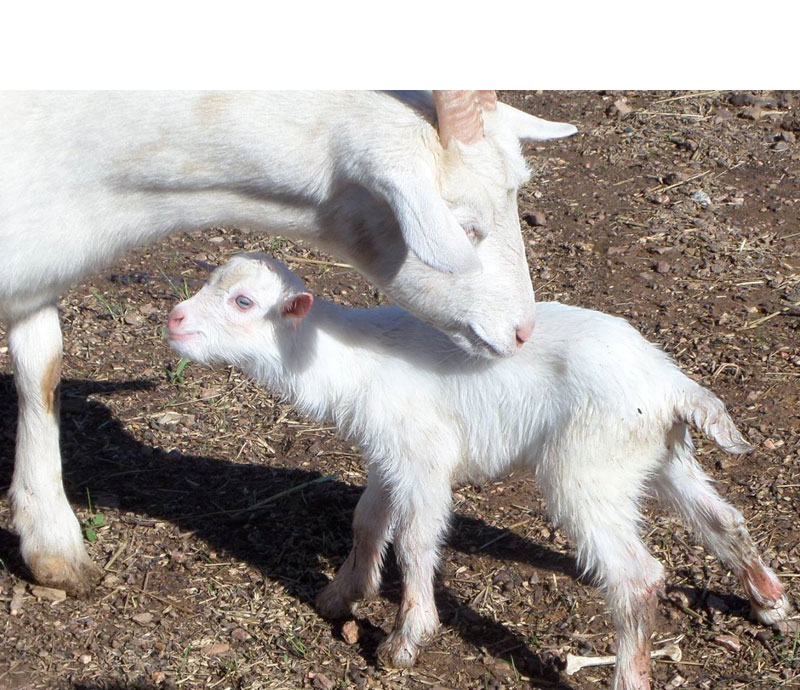
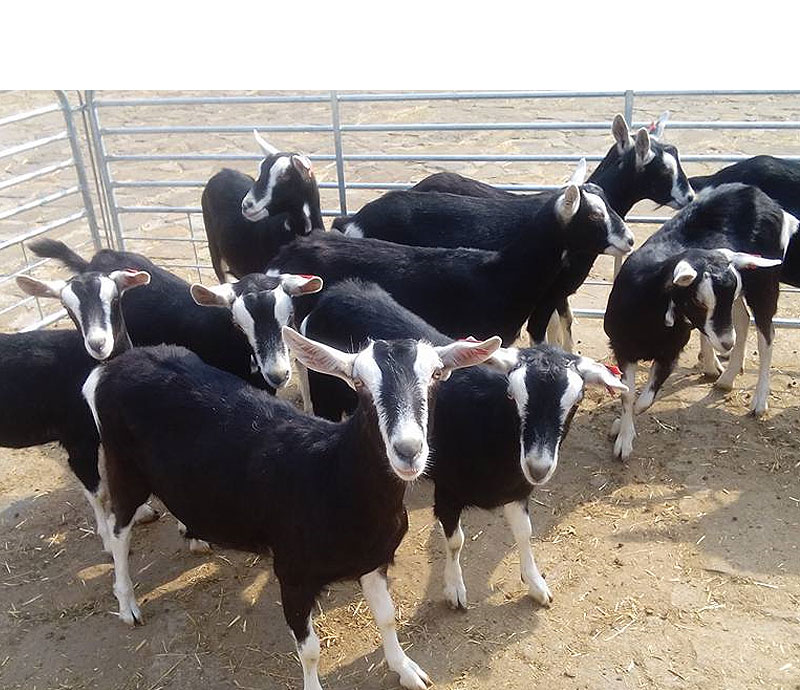
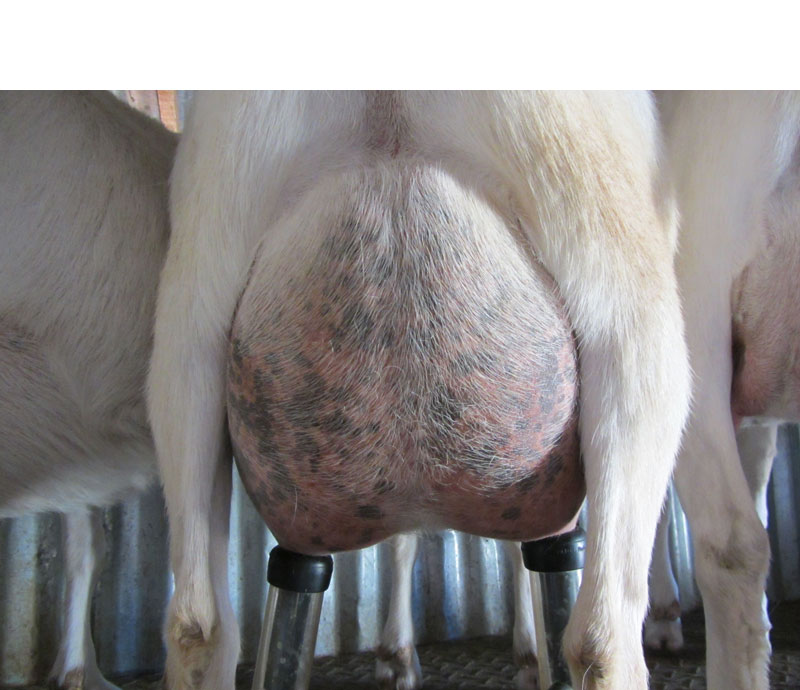
The usefulness of goats as dairy animals was recognized long before recorded history. Goats, together with dogs were the first animals to be domesticated. They are mentioned several times in the Bible. In Greek mythology we read that the baby Zeus drank milk from the teats of the goat nymph Amalthea.
Goats were carried on sailing ships as a source of fresh milk.
More goats milk is globally consumed daily than cow’s milk.
The first reference to goats in South African history date back to 1661, 9 years after Jan van Riebeeck settled in the Cape. An expedition to the North rested on the banks of the Olifants river, where they met a Namaqua prince who gave them a goat as a present.
In 1896 Great Constantia had Milk Goat herd supplying the farm with milk and manure for the vineyards.
In 1898 the Cape Agricultural Department imported 12 Saanen does and 3 Saanen bucks from Switzerland.
The South African Milch Goat Association was founded in 1926 and affiliated with the British Goat Society.
In 1958 the South African Milch Goat Association was founded and affiliated with the S.A. Studbook and Animal Improvement Society.



The goat has, for centuries, been intertwined in cultural history and tradition. Its long association with man has made it a common subject, or object, in myths, folklore, and fairytales. Unfortunately, because of some of these histories goats sometime have a negative connotation. If the origins of these uses could be understood then it is more likely that consumers will accept goats for what they are – an important livestock species that also has symbolic associations.
In the Egyptian town of Mendes the sacred goat Ba-neb-Djedet (the Billy goat, lord of Djedjet) was a symbol of fertility and abundance (The Gods and Symbols of Ancient Egypt, 1974). In Celtic religions, the goat represented fertility, and goat-horned divinities are recorded in Britain and Gaul (France) (Green, 1992). The use of goat’s milk by the Gauls is also, comically, illustrated in “Asterix and the Banquet” (Goscinny and Uderzo, 1979). In Scotland, images of the goat have been found to represent fertility and aggression. In British fairytale, the goat is pictured as the steed of the king dwarf from Fairyland (Briggs, 1978). The Urisk or Uruisg was a solitary rough kind of brownie, half-human, half-goat, who herded cattle, did work around the farm, and was very lucky to have in the house (Briggs, 1978). In Norwegian myth, a goat that fed on the great world-tree, Yggdrasill, gave mead instead of milk, and this mead supplied the great feasts that the gods held (Barber, 1979). In Germany, an altar dedicated to the triple Matronae has, on the reverse, a carving of a snake-entwined tree and a triple bodied goat.
During the Renaissance dances were often styled on animals and birds. More sedate dances imitate the behaviour of birds such as the peacock, whereas the French dance, the capriole, imitated the bawdy behaviour of the goat (Lonsdale, 1981.). The most significant goat-use in mythology is most probably that of the mythology surrounding Dionysus, or Bacchus. This god was the god of vegetation and the vine, and the goat was sacred to him. Thus, the Greek tradegy plays had their origin in the festivals that were held to commemorate him and the harvest. The word tragedy has its origins in the word “tragoidia” or goat song, from “tragos” (goat) and “aeidein” (to sing). The word referred to either the prize, a goat, which was awarded to the dramatists whose plays won the earliest competitions or to the dress (goat skins) of the performers, or to the goat that was sacrificed in the primitive rituals from which the tragedy developed (New Encyclopaedia Britannica, 1986).
Also related to this mythology is the better-known Pan or the satyrs (the followers of Bacchus). The Zodiac sign of Capricorn is believed to be a representation of the Greek god Pan. The fishtail seen in this sign is thought to originate from the incident where Pan, trying to avoid the monster Typhon, jumped into the water just as he was changing into animal shape. The half above the water assumed the shape of a goat, while the lower half beneath the water assumed the shape of a fish (New Encyclopaedia Britannica, 1986). The devil is often depicted as a Satyr (hence the word Satan). These creatures with the horns, legs and tail of a goat were symbols of abundance, wine, dance, and debauchery. Now if one recalls that “wine, women and song” were not looked on favourably by the church, one can realise how the goat got labelled as being a “devilish” creature. In medieval times, the Roman Catholic priests were at their wits-end trying to draw the pagans into Christianity. What they did was, they used the pagan symbols to draw the masses to the churches by using these “devilish-looking” creatures as adornment on the outsides of the church buildings. Thus, originated the gargoyles (from the French word “to gurgle” – since these structures essentially serve as the gutters of the buildings). The pagans felt comfortable entering a place that was festooned by creatures so familiar to them. Over time however, as the new faith was adopted, these very same creatures were used to denote that which is evil and were used to graphically illustrate the beasts that the followers would encounter in hell for their sins. A ‘faun’ was a Latin rural deity with goat’s horns, legs, and tail (Pocket Oxford Dictionary, 1984).
In Greek and Roman mythology the baby Zeus was raised by the goat Amalthea after he was hidden from his cannibalistic father Cronus by his mother Rhea. For her good work, the goat Amalthea was forever venerated by being changed into a constellation (Guerber, 1943).
The goat’s influence was also seen in China, where the goat spirit was seen as a goat that had a white face, a head furnished with horns, a long beard, and a special kind of headdress. So too, the goat is one of the animals used to mark the Chinese calendar. In Mongolia it was worshipped as a composite god being combined with the image of the dog that had two horns on its head or the hair done in the shape of two short horns (Werner, 1977).
Even in the northwest Pacific, where the early tribes of the Tsimshian lived the goat was part of the belief system. The people of Temlaham, the earthly paradise of the Tsimshian people, did not maintain the required good relation with the goats, which they hunted. In a fearful retribution, the goats summoned an earthquake that destroyed all the hunters except one that had showed mercy to a mistreated kid in the past. Even the Eskimos had songs and poems to invoke the animal or guardian spirit of the goat (Lonsdale, 1981).
Apart from goats being woven into Arabian folklore when the black goat-hair tents of the nomadic Bedouin are described (black animals were considered the possession of the rich), goats are sometimes the subject of Arabian folklore. In the story of how the fox got back its tail, it was goats and goat’s milk that sent him on a search to win it back. In “Little Mangy One” a little goat bravely saves his two brothers from the belly of a mean hyena. The goat’s intelligence is portrayed in “Two Close Calls” when the goat outwits both the jackal and the lion (Bushnaq, 1986).
Different cultural traditions in southern Africa place differing values on goats and their products. Large flocks were present amongst the Pedi people in the mid 1800’s and were kept mostly as a source of wealth but only in association with cattle. Quin (1959) comments that the Pedi evaluate their goats as follows, “1 ox = 5 sheep or 10 goats, 1 heifer or cow = 7 sheep or 14 goats”. In terms of monetary value at the time, he mentions, that cattle were valued at £5, sheep at £1 and goats at 10 shillings. Within these societies, goats are still often used in rituals and sacrifices although they have little value in themselves. As far as folklore is concerned; a Nigerian story tells of how the goat was domesticated. The Yoruba story tells how the animals used to drink from a common pool that was cleaned by the animals once a year. The crafty goat avoided the task until it evoked the anger of the Leopard, which sprang at it with a roar. The goat leapt sideways and ran with all speed to the human village. Only there did the Leopard turn back and the Goat has been quite content to live with human beings ever since, but the Leopard kills goats whenever it finds them straying outside the village. In Ghana, a story very reminiscent of Jacob and Esau involves the goat that was told by God to organise that the more diligent of two brothers received the best of the land to be shared between them. As in the Biblical story, the less obedient son disguised himself and received the best portion of land (Parrinder, 1982).
In his book about the importance of various animals to African spirituality, Credo Mutwa (1996) writes the following poem about the goat:
I hear you cry, oh imbuzi, on the altars of our ancestors
I hear you cry, oh goat, in the shrines of our forefathers
You are the one who asks the questions
That is the meaning of your name
The animal which asks questions
Questions which often have no answer
You are the delight of the old men
Old men without teeth who grow old on your milk
You are also the delight of the gods
The angry gods who adore your flesh
You are the creature that came from the heavens
Sent by the gods to human beings on Earth
That whenever we seek knowledge from those above
We must make you ask the gods the question
You are a cousin of the impala that roam the plains of our fatherland
They cannot ask any questions, but you can
For you, oh goat – you are the wisest of the wise!
Your hooves have etched the soil of Africa deeply
Your bleating has been heard from one end of the land to the other
You are the joy of our children, the joy of our little sons and daughters who love to caress your beard, and to brush your ears, and to count the rings in your horns
Your hide keeps our grandmothers warm and our grandfathers from shivering
Your eyes are as gentle as those of a lover
But your butting is forceful as that of a Bapedi warrior!
You are the lover of the trees
You are the one who remains alive when other animals have long since perished from the face of the land
For you are the imbuzi, the asker of questions
You are the goat!
You are the animal!
Our sisters often say that your smell is overpowering, but they fail to understand that it is the perfume of wisdom
Our brothers often say that your beard is ridiculous, but they do not know it is the beard of wisdom
Our cousins say that your genitals dangle like drunkards’ calabashes inside a beer-brewing hut
But they do not know that they are the gonads of fertility itself
The gods revere you, oh imbuzi
And the demons fear you below
For you are the goat, the one who asks many questions
Bayete!
In almost all the South African languages, “goat” means “the questioning animal” or “that which asks a question”; in Zulu, imbuzi, in Xhosa ibhokhwe, in Sotho and Setswana pudi and, in Venda, Tonga and Shangaan, mpundzi. This is because the goat has been used for centuries by the tribes of South Africa to communicate with the gods and ancestral spirits (Mutwa, 1996). The colour, sex and age of a goat slaughtered for cultural purposes are important, but vary from tribe to tribe (ARC, 1999; Mkhwanazi, 1997; Mutwa, 1996). So, for example, the Zulus consider a black goat as possessing the most powerful magic, a reddish-brown goat is believed to prevent conflict and bloodshed, an all-white goat is used to bless a wedding ceremony, a black-and-white goat is used in thanksgiving for wishes granted, and a red-and-white goat in thanksgiving for ending conflict (Mutwa, 1996). White goats are also slaughtered for the wedding ceremonies of the Tsonga, Pedi and Ndebele (ARC, 1999). Red or brown goats are used by young sangoma (ithwasa) once they have completed their training (Mkhwanazi, 1997). Black goats are slaughtered when someone has bad luck and white goats are used for thanksgiving, apologies, cleansing and requests (Mkhwanazi, 1997).
In general, ceremonies in which goats are used include, lobola (wedding dowries), religious rituals, asking for luck, chasing away bad luck, initiation, weddings, child births and birthdays, reporting (amadlozi) and asking for forgiveness (ARC, 1999). The colour and sex of the animal is often communicated in a dream to the person who will slaughter the goat (ARC, 1999; Mutwa, 1996).
In the stories of Minnie Postma (1956), where she chronicles Basotho folklore, several stories capture the significance of goats. The use of goat’s milk is mentioned in ‘Litsomo in die kombuis – ‘Hlankanyana’, and goats are used for lobola in ‘Die Laaste Legende – ‘Tsaile’ and ‘Die Droomverhaal – Lehe’. In a further work by Postma (1974) ‘Molaetsane’, she tells the story of a barren heifer that is driven away from the kraal she loves and later gives birth to many cattle and goats. These goats, speak and walk like humans, and care for Molaetsane, grinding corn, brewing beer, making porridge, fetching water, making clay pots and cooking meat.
The Shona have several superstitions about living things. It is believed that a man should not eat the intestines of a goat, lest he forget his trade and soon be out of a job (Miller, 1979). The Sotho-Tswana also practice ancestor worship, especially for curing certain illnesses. A goat can be brought into the presence of the patient, then killed by being pierced with a needle behind the shoulder. The longer it takes to die, and the louder it bleats, the more it will please the spirit, and thus affect a satisfactory cure (Miller, 1979). This is in contrast to the practices of the Zulu, who treat a goat to be slaughtered with the utmost respect and reverence. Only a person who is trained and skilled enough to cause the sacrificial animal the minimum amount of pain and agony may slaughter a goat (Mutwa, 1996).